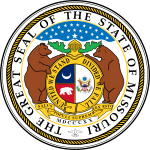State of Missouri
| Missouri state symbols | |
|---|---|

The Flag of Missouri
|
|

The Seal of Missouri
|
|
| Living insignia | |
| Amphibian | American bullfrog |
| Bird | Eastern bluebird |
| Fish | Channel catfish |
| Flower | White hawthorn |
| Grass | Big bluestem |
| Horse breed | Missouri Fox Trotter |
| Insect | Western honey bee |
| Mammal | Missouri Mule |
| Tree | Flowering Dogwood |
| Inanimate insignia | |
| Dance | Square dance |
| Dinosaur | Hypsibema missouriensis |
| Fossil | Crinoid |
| Gemstone | Beryl |
| Mineral | Galena |
| Motto | Salus populi suprema lex esto (Latin) |
| Rock | Mozarkite |
| Soil | Menfro |
| Song | "Missouri Waltz" |
| State route marker | |
 |
|
| State quarter | |

Released in 2003
|
|
| Lists of United States state symbols | |
 |
|
|
|
Missouri (see pronunciations) is a state in the Midwestern region of the United States, achieving statehood in 1821. With over six million residents, it is the eighteenth most populous state and host to the mean center of United States population. The largest urban areas are St. Louis, Kansas City, Springfield, and Columbia. The capitol is in Jefferson City on the Missouri River. The state is the twenty-first most extensive by area and is geographically diverse. The Northern Plains were once covered by glaciers, then tallgrass prairie, and now the deep soils yield great agricultural productivity. In the South are the Ozarks, a forested highland, providing timber, minerals, and recreation. The Mississippi River forms the eastern border of the state, eventually flowing into the swampy Missouri Bootheel.
Humans have inhabited what we now call Missouri for at least 12,000 years. The Mississippian culture built cities and mounds, before declining in the 1300s. When European explorers arrived in the 1600s they encountered the Osage and Missouria nations. The French established Louisiana, a part of New France, and founded Ste. Genevieve in 1735 and St. Louis in 1764. After a brief period of Spanish rule, the United States acquired the Louisiana Purchase in 1803. Americans from the Upland South, including enslaved African Americans, rushed into the new Missouri Territory. Many from Virginia, Kentucky, and Tennessee settled in the Boonslick area of Mid-Missouri. Soon after, heavy German immigration formed the Missouri Rhineland. Missouri played a central role in the westward expansion of the United States, as memorialized by the Gateway Arch. The Pony Express, Oregon Trail, Santa Fe Trail, and California Trail all began in Missouri. As a border state, Missouri's role in the American Civil War was complex and there were many conflicts within. After the war, both Greater St. Louis and the Kansas City metropolitan area became centers of industrialization and business. Today, the state is divided into 114 counties and the independent city of St. Louis.
...
Wikipedia



